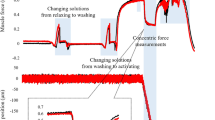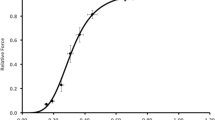Abstract
The β-adrenergic receptor stimulation improves endurance in fast twitch muscles and these effects are sensitive to extracellular Ca2+ influx. Present study is aimed to determine the effects of adrenaline, with different concentrations of extracellular Ca2+\(\left( {{\text{Ca}}_{\text{ECF}}^{ 2+ } } \right)\), on the contractility and endurance of slow twitch muscles during high frequency stimulations (HFS). Isolated soleus of rabbit was electrically stimulated (strength; 50 Hz, duration; 0.5 ms) in the presence (Test) of adrenaline (1 × 10−7 mM) or without adrenaline (CTL). Fatigue was induced with HFS (80 Hz) for the duration of 20 s. Contractions were recorded through isometric transducer connected with Powerlab. Kreb’s buffer was used with three compositions: standard with 2.5 mM Ca2+ (Ca-S), Ca2+ free buffer (Ca-F) and buffer with raised Ca2+ i.e., 10 mM (Ca-R). Muscles endurance was assessed by measuring the decline in tetanic tension in the terms of percentage (%Pmax) and rate of decline in tetanic tension (dP/dt). During 20 s, %Pmax showed reduction of only 10% in Ca-S. This decline was enhanced in Ca-F (50%) and reduced in Ca-R (6%). Effect of adrenaline was observed only in Ca-F where %Pmax was about 20% greater in Test than CTL. These effects were not observed in both Ca-S and Ca-R during 20 s. However, when duration of stimulation was increased to 120 or 150 s in Ca-S and Ca-R respectively, decline in %Pmax was less in Test as compared to CTL. Thus, \({\text{Ca}}_{\text{ECF}}^{ 2+ }\) plays protective role against fatigue during continuous HFS in slow twitch muscles. In addition, adrenaline improves the muscles endurance during fatiguing contraction but these effects are not mediated through \({\text{Ca}}_{\text{ECF}}^{ 2+ }\) influx.



Similar content being viewed by others
References
Allen DG, Lannergren J, Westerblad H (1995) Muscle cell function during prolonged activity: cellular mechanism of fatigue. Exp Physiol 80:497–527
Allen DG, Lamb GD, Westerblad H (2008) Skeletal muscle fatigue: cellular mechanisms. Physiol Rev 88:287–332
Arreola J, Calvo J, Garcia MC, Sanchez JA (1987a) Modulation of calcium channels of twitch skeletal muscle fibres of the frog by adrenaline and cyclic adenosine monophosphate. J Physiol (Lond) 393:307–330
Arreola J, Calvo J, Garcia MC, Sanchez JA (1987b) Modulation of calcium channels of twitch skeletal muscle fibres of the frog by adrenaline and cyclic adenosine monophosphate. J Physiol 393:307–330
Balog EM, Fitts RH (2001) Effects of depolarization and low intracellular pH on charge movement currents of frog skeletal muscle fibers. J Appl Physiol 90:228–234
Bannister R, Pessah IN, Beam K (2009) The skeletal L-type Ca2+ current is a major contributor to excitation-coupled Ca(2+) entry. J Gen Physiol 133:79–91
Bowman WC, Zaimi E (1958) The effects of adrenaline, noradrenaline and isoprenaline on skeletal muscles contraction in the cat. J Physiol I44:92–107
Brum G, Fitts R, Pizarro G, Rios E (1988) Voltage sensors of the frog skeletal muscle membrane require calcium to function in excitation-contraction coupling. J Physiol 398:475–505
Cairns SP, Borrani F (2015) β-Adrenergic modulation of skeletal muscle contraction: key role of excitation-contraction coupling. J Physiol 593:4713–4727
Cairns SP, Dulhunty AF (1993) The effects of beta-adrenoceptor activation on contraction in isolated fast- and slow-twitch skeletal muscle fibres of the rat. Br J Pharmacol 110:1133–1141
Cairns SP, Dulhunty AF (1994) Beta-adrenoceptor activation slows high-frequency fatigue in skeletal muscle fibers of the rat. Am J Physiol Cell Physiol 266:C1204–C1209
Cairns SP, Hing WA, Slack JR, Mills RG, Loiselle DS (1998) Role of extracellular [Ca2+] in fatigue of isolated mammalian skeletal muscle. J Appl Physiol 84:1395–1406
Clausen T, Andersen SL, Flatman JA (1993) Na+/K+ pump stimulation elicits recovery of contractility in K(+)-paralysed rat muscle. J Physiol 472:521–536
Cully TR, Edwards JN, Murphy RM, Launikonis BS (2016) A quantitative description of tubular system Ca(2+) handling in fast- and slow-twitch muscle fibres. J Physiol 594:2795–2810
Dirksena RT, Beam KG (1999) Role of calcium permeation in dihydropyridine receptor function: insights into channel gating and excitation–contraction coupling. J Gen Physiol 114:3393–3404
Ducret T, Vandebrouck C, Cao ML, Lebacq J, Gailly P (2006) Functional role of store-operated and stretch-activated channels in murine adult skeletal muscle fibres. J Physiol 575:913–924
Dulhunty A, Gage PW (1988) Effects of extracellular calcium concentration and dihydropyridines on contraction mammalian skeletal muscle. J Physiol 399:63–80
Dutka TL, Lamb GD (2000) Effect of lactate on depolarization-induced Ca2+ release in mechanically skinned skeletal muscle fibers. Am J Physiol 278:C517–C525
Emrick MA, Sadilek M, Konoki K, Catterall WA (2010) Beta-adrenergic-regulated phosphorylation of the skeletal muscle Ca(V)1.1 channel in the fight-or-flight response. Proc Natl Acad Sci USA 107:18712–18717
Favero TG (1999) Sarcoplasmic reticulum Ca2+ release and muscle fatigue. J Appl Physiol 87:471–483
Friedrich O, Ehmer T, Uttenweiler D, Vogel M, Barry PH, Fink RH (2001) Numerical analysis of Ca2+ depletion in the transverse tubular system of mammalian muscle. Biophys J 80:2046–2055
Germinario E, Esposito A, Midrio M, Peron S, Palade PT, Betto R, Danieli-Betto D (2008) High-frequency fatigue of skeletal muscle: role of extracellular Ca(2+). Euro J Appl Physiol 104:445–453
Gissel H, Clausen T (2000) Excitation-induced Ca2+ influx in rat soleus and EDL muscle: mechanisms and effects on cellular integrity. Am J Physiol 279:R917–R924
Hidalgo J, Luxoro M, Rojas E (1979) On the role of extracellular calcium in triggering contraction in muscle fibers from barnacle under membrane potential control. J Physiol 288:313–330
Holmberg E, Waldeck B (1980) On the possible role of potassium ions in the action of terbutaline on skeletal muscle contractions. Acta Pharmacol Toxicol 46:141–149
Huerta M, Muniz J, Trujillo X, Lomeli J (1991) Adrenergic modulation of the K+ contractures in tonic skeletal muscle fibers of the frog. Jpn J Physiol 41:851–860
Johnson BD et al (1997) Modulation of the cloned skeletal muscle L-type Ca2+ channel by anchored cAMP-dependent protein kinase. J Neurosci 17:1243–1255
Kurebayashi N, Ogawa Y (2001) Depletion of Ca2+ in the sarcoplasmic reticulum stimulates Ca2+ entry into mouse skeletal muscle fibres. J Physiol 533:185–199
Lamb G (2001) Excitation-contraction coupling in skeletal muscle: comparisons with cardiac muscle. Clin Exp Pharm Physiol 27:216–224
Launikonis BS, Stephenson DG, Friedrich O (2009) Rapid Ca2+ flux through the transverse tubular membrane, activated by individual action potentials in mammalian skeletal muscle. J Physiol 587:2299–2312
Ma J, Pan Z (2003) Junctional membrane structure and store operated calcium entry in muscle cells. Front Biosci 8:d242–d255
Meissner G, Lu X (1995) Dihydropyridine receptor-ryanodine receptor interactions in skeletal muscle excitation-contraction coupling. Biosci Rep 15:399–408
Nabauer M, Callewaert G, Cleemann L, Morad M (1989) Regulation of calcium release is gated by calcium current, not gating charge, in cardiac myocytes. Science 244:800–803
Naro F et al (2003) Increase in cytosolic Ca2+ induced by elevation of extracellular Ca2+ in skeletal myogenic cells. Am J Physiol 284:C969–976
Oz M, Frank GB (1991) Decrease in the size of tetanic responses produced by nitrendipine or by extracellular calcium ion removal without blocking twitches or action potentials in skeletal muscle. J Pharmacol Exp Ther 257:575–581
Rizvi S, Azeem M (2013) Adrenaline improves endurance of rabbit gastrocnemius: a study with continuous high frequency stimulation. Pak J Pharm Sci 26:773–777
Savanur A, Ali SA, Munir I, Abbasi A, Alam M, Shaikh HA (2014) Pharmacological and biochemical studies on the venom of a clinically important viper snake (Echis carinatus) of Pakistan. Toxicon 80:47–57
Schiaffino S, Reggiani C (2011) Fiber types in mammalian skeletal muscles. Physiol Rev 91:1447–1531
Serratos HG, Hill L, Aguilera RV (1981) Effects of catecholamine and cyclic amp on excitation-contraction coupling in isolated skeletal muscle fibres of the frog. J Physiol 315:267–282
Tanabe T et al (1987) Primary structure of the receptor for calcium channel blockers from skeletal muscle. Nature 328:313–318
Tashiro N (1973) Effects of isoprenaline on contractions of directly stimulated fast and slow skeletal muscles of the guinea-pig. Br J Pharmacol 48(121–113):121
Williams JH, Barnes WS (1989) Extracellular calcium and the inotropic effect of epinephrine on frog skeletal muscle. Can J Physiol Pharmacol 67:1574–1579
Williams J, Ward C (1991) Dihydropyridine effects on skeletal muscle fatigue. J Physiol (Paris) 85:235–238
Zhao X et al (2005) Enhanced resistance to fatigue and altered calcium handling properties of sarcalumenin knockout mice. Physiol Genomics 23:72–78
Acknowledgements
This study was funded by Higher Education Commission Pakistan.
Author information
Authors and Affiliations
Corresponding author
Additional information
Publisher's Note
Springer Nature remains neutral with regard to jurisdictional claims in published maps and institutional affiliations.
Rights and permissions
About this article
Cite this article
Rizvi, M.H., Abdul Azeem, M. & Savanur, A. Effects of adrenaline on contractility and endurance of isolated mammalian soleus with different calcium concentrations. J Muscle Res Cell Motil 40, 373–378 (2019). https://doi.org/10.1007/s10974-019-09551-9
Received:
Accepted:
Published:
Issue Date:
DOI: https://doi.org/10.1007/s10974-019-09551-9




